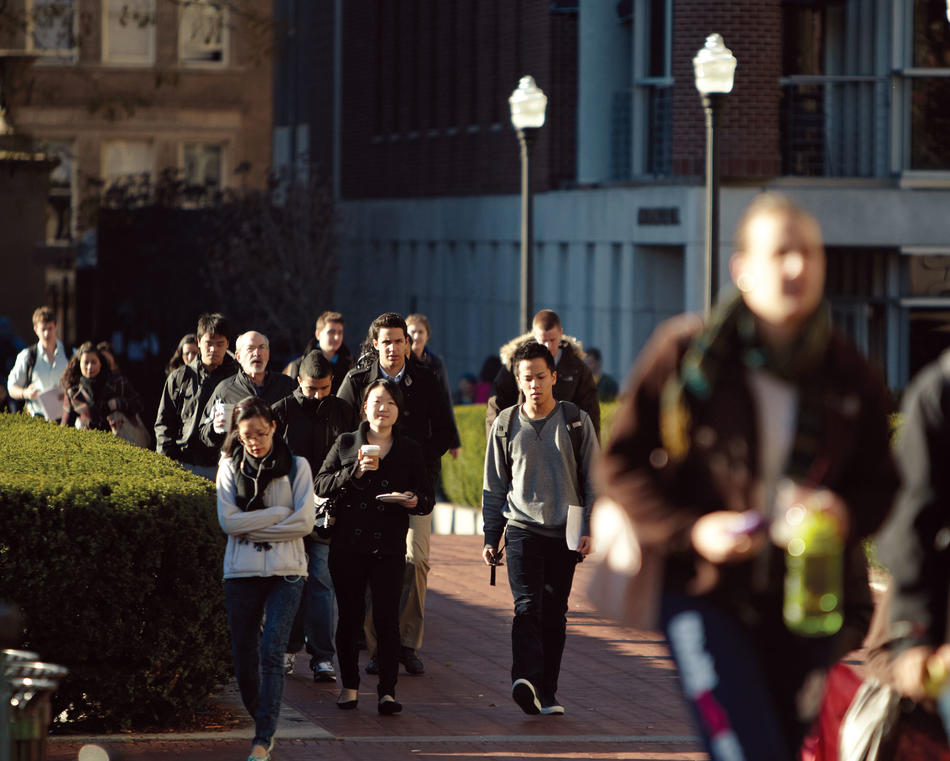Today, thousands of undergraduates at Columbia College and at Columbia Engineering receive more financial aid than they used to. And students across Columbia have access to more distinguished faculty, as well as to new science labs, studio art spaces, and academic-advising centers.
These are just a few of the changes that have taken place at Columbia as a result of an unprecedented wave of giving in recent years. Since 2004, more than 160,000 alumni, parents, and friends of the University have donated nearly $4 billion through the Columbia Campaign, making it one of the most successful fundraising and alumni-outreach efforts in the history of higher education.
“It’s amazing that so many people have come forward to meet our fundraising goals, even through the worst recession this country has faced since the 1930s,” says President Lee C. Bollinger. “This is an achievement that every person who cares about this institution should take pride in.”
In early December, Bollinger announced that the Columbia Campaign, which originally aimed to raise $4 billion by the end of 2011, is close to surpassing its initial target a full year ahead of schedule. Now the University is expanding the campaign in hopes of raising an additional $1 billion by the end of 2013. According to University officials, this will enable Columbia to raise money for a variety of unmet needs, as well as for new priorities as they emerge.
The primary goals for the expanded effort are to raise money for financial aid, such as through a major initiative to ensure that the College remains affordable to the best-qualified students; to support faculty, especially through endowed professorships; and to make possible the construction of new arts, business school, and conference facilities in Manhattanville, a medical education building at the University’s medical campus, and a sports center at the Baker Athletics Complex in Upper Manhattan. Other key targets for support are the University’s global initiatives, which include a growing series of Global Centers that advance Columbia research and teaching in foreign cities; the Graduate School of Architecture, Planning and Preservation’s international network of Studio-X experimental design spaces; and financial aid for international students.
“I think that there’s a collective sense right now that if you want to put your resources to good use, there’s no better place to give money to than Columbia,” says Bollinger. “There are exciting things happening at Columbia today — in areas ranging from neuroscience to environmental development to globalization — and people are responding to that. The success of the Columbia Campaign shows there’s more potential than we realized for fulfilling our hopes and ambitions for this University, so we have to keep going.”
Big ideas
When the Columbia Campaign was publicly announced in 2006, the goal of raising $4 billion seemed remarkably ambitious. At the time, no university had ever undertaken a $4 billion campaign.
However, Bollinger and the University Trustees, including the chair of the board’s alumni and development committee, Richard E. Witten ’75CC, saw a lot of potential. Columbia for many years had lagged behind its peers in terms of the services it provided to its alumni, as well as in the opportunities it gave them to stay involved in the life of the University. “There was an urban myth that Columbia alumni didn’t really want to connect with the University in the way that alumni of other Ivies do,” says Susan K. Feagin ’74GS, who recently left her post as the executive vice president for university development and alumni relations to become a special adviser to Bollinger. “But that wasn’t true, as alumni now have proved.”
In 2005, the University, building upon growing alumni-outreach efforts taking place at several of its schools, created the Columbia Alumni Association (CAA). The CAA now encompasses more than 80 regional alumni clubs and affinity groups around the globe. It sponsors exclusive lectures, symposia, and concerts. It also has asked alumni what types of services they want from Columbia; the University has responded by offering more library privileges and online career services to alumni, by creating the Columbia Alumni Center at 622 West 113th Street on the Morningside Campus, and by inviting alumni to more networking events in New York City and around the world.
The percentage of Columbia graduates who say they’re pleased with their alumni experience has increased from 50 percent to nearly 75 percent in recent years. Many alumni are volunteering as guest lecturers on campus, mentoring students and young graduates, and helping organize social events for their local alumni clubs. And they are donating: Some 88,000 alumni have given to the Columbia Campaign, creating a historic spike in giving.
“Alumni and other donors were apparently waiting for an invitation to get involved with Columbia, and to show their support,” says Fred Van Sickle, who succeeded Feagin as executive vice president for university development and alumni relations on January 1. “What they’re responding to is the energy and momentum they see at this institution. Our academic programs are clearly among the very best in the world, and now we have a level of alumni spirit and engagement to match.”
“We are incredibly proud that friends and alumni of Columbia have been energized by the University’s momentum under Lee Bollinger’s leadership,” says Witten, who is vice chair of the University Trustees and a cochair of the campaign. “The financial success of this effort is, of course, extremely gratifying. But equally significant is the fact that more than 160,000 donors have taken part in the Columbia Campaign. Their support and enthusiasm has been infectious and will bring enormous momentum to the years and goals ahead, leading the effort to strengthen Columbia and the world in which we exist.”
William V. Campbell ’62CC‚ ’64TC, Mark E. Kingdon ’71CC‚ Philip L. Milstein ’71CC, ‚and Esta E. Stecher ’82LAW, all of whom are University Trustees, and Roy Vagelos ’54PS, ’90HON, chair of the Columbia University Medical Center Board of Visitors, have also served as cochairs of the campaign. In addition, three more alumni have stepped forward to volunteer as cochairs on the expanded campaign: Armen Avanessians ’83SEAS, Jonathan Lavine ’88CC, and Clyde Wu ’56PS. The honorary cochairs are Trustee Gerry Lenfest ’58LAW and Tussi Kluge, wife of the late John W. Kluge ’37CC, ’88HON.
Tradition of access
Providing money for financial aid continues to be a key goal of the Columbia Campaign. This is because the University must perform a budgetary balancing act to control costs for its students: While the College enrolls an unusually large number of low-income students for an Ivy, the University has a much smaller endowment than similarly prestigious institutions, which means that less money is available for student aid.
As part of the Columbia Campaign, the University so far has raised $716 million for financial aid endowment across all of its schools. This effort got a big kick-start in 2007, when John W. Kluge pledged $400 million to Columbia, all to support financial aid for undergraduate and graduate students. Kluge allowed part of his gift to be used to create matching programs, thus prompting dozens of others to donate more than $15 million for financial aid. In addition, the smaller donations that alumni make every year to the annual funds of Columbia’s schools support financial aid; about half of the money given each year to the Columbia College Fund goes toward aid packages.
In recent years, an increase in donations for financial aid has helped Columbia replace loans with grants in the aid packages that it awards to College and engineering undergraduates.
“There are only a handful of institutions in the United States that can claim to truly have a need-blind admissions policy, and Columbia is one of them,” says Bollinger. “There is nothing more important that people can do for this University than give for financial aid.”
Another ongoing priority for the Columbia Campaign is to raise money for faculty. The campaign has raised tens of millions of dollars to support the creation of 134 endowed professorships, for instance. Donors often fund endowed professorships in a field of personal interest while linking their name, or that of a family member, to an eminent professor who holds the chair they created.
“For professors to be awarded endowed chairs is also very prestigious, so these gifts help Columbia reward our best senior faculty and recruit top-notch people,” says College dean Michele Moody-Adams. “This has a direct payoff for the quality of our undergraduate education.”
Among the campaign’s signature gifts for endowed professorships is a donation of $48 million from Gerry Lenfest, which, by establishing matching programs, is helping to fund 25 faculty positions in the arts and sciences and 10 at the law school. In addition, Arthur J. Samberg ’67BUS pledged $25 million for endowed professorships at Columbia Business School, and Armen Avanessians and his wife, Janette, have given generously for endowed chairs at the engineering school.
The campaign continues to raise money for faculty at various stages of their careers, such as through the Endowed Postdoctoral Core Lectureship program, which supports the College’s brightest young faculty teaching in the Core Curriculum.
Bricks and mortar
Space is a precious commodity for urban universities, and especially for Columbia. Among the Ivies, CU has the fewest square feet per student.
But Columbia is planning to build state-of-the-art facilities for some of its most space-deprived programs in the years ahead. The campaign so far has received landmark gifts of $250 million from the late Dawn M. Greene ’83HON and the Jerome L. Greene Foundation for the construction of the Jerome L. Greene Science Center, which will serve as the home to the University’s expanding Mind, Brain, and Behavior Initiative; $100 million from Henry R. Kravis ’69BUS for new business school facilities as part of the University’s planned 17-acre expansion in Manhattanville; $50 million from Roy Vagelos and his wife, Diana Vagelos ’55BC, for a new medical education building at Columbia University Medical Center; and gifts for a new sports center to be named in honor of William V. Campbell at the University’s Baker Athletics Complex.
The campaign aims to raise additional gifts for each of these projects, as well as for a new conference center and an arts venue in Manhattanville.
“The University’s physical expansion is one of the most important ingredients in preparing Columbia for its long-term future,” says Bollinger. “Through the generosity of the entire Columbia community, we now have a historic opportunity to create the physical facilities that will allow our programs to reach their full potential.”



